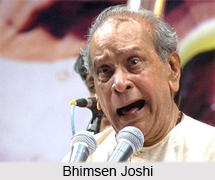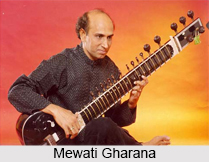 Music Gharanas of Northern India comprises of an organizational system of musicians or dancers following a particular style by lineage in northern part of the country. It also symbolizes a specific ideology of music. These musical ideologies changes from one Gharana to another. Compositions of a particular Gharana affect the thinking, performance and teachings of the music.
Music Gharanas of Northern India comprises of an organizational system of musicians or dancers following a particular style by lineage in northern part of the country. It also symbolizes a specific ideology of music. These musical ideologies changes from one Gharana to another. Compositions of a particular Gharana affect the thinking, performance and teachings of the music.
Agra Gharana
Agra Gharana is one of the most distinguished Music Gharanas of Northern India. A descendent of Nauhar Bani, this tradition of Hindustani classical vocal music was founded in the mid-19th century. Nayaka Gopala is the first renowned musician of this Gharana. Previously only Dhrupad-Dhamar style was prevalent in this Gharana but later Khayal style was also incorporated in it by Ustad Ghagghe Khudabuksh. The gayaki or characteristic of the compositions of this Gharana are the amalgamation of Dhrupad-Dhamar and Khayal. Tom-alaap usually marks the commencement of the performances and other compositions include Thumri, Tarana, Tappa, Dadra, Hori, Ghazal, Rasiya, Kaul etc.
Kirana Gharana
Among Hindustani Khayal Gharanas, Kirana Gharana is a prominent one. The famous Dhrupad singer, Gopal Nayak, founded this Gharana in the 13th century. Gopal Nayak belonged to Shamli district of Uttar Pradesh. The epitomes of this Gharana are Bhimsen Joshi, Abdul Wahid Khan, Ameer Khan and Abdul Karim Khan. In course of time, Karnataka and Maharashtra have become the centres of this style of singing and the main exponents of this Gharana belong to these states. The unique and most enchanting feature of this singing is the sargam taan which refers to the waving patters of musical notes. The most popular ragas of this Gharana are Marwa, Todi, Multani, Lalit, Patdeep, Puriya, Darbari Kanhara, Shuddha Kalyan and Komal-Rishabh Asavari.
Patiala Gharana
Another famous music gharana of northern India is Patiala Gharana. It was founded by Ustad Ali Baksh Khan and Ustad Fateh Ali Khan. The royal family of Patiala initially practiced this style of singing after Mughal Dynasty declined in the 18th century. Taals most commonly used with these compositions are Teentaal and Ektaal. Khayals and Thumris are the most emphasized singings in this Gharana.
 Rampur-Sahaswan Gharana
Rampur-Sahaswan Gharana
Another Gharana of Hindustani Classical Music is Rampur-Sahaswan Gharana. It is mainly focussed in the towns of northern Uttar Pradesh namely Rampur and Sahaswan. The founder of this Gharana is Ustad Inayat Hussain Khan. The style of singing closely resembles with Gwalior Gharana.
Delhi Gharana
Founded in North-East India, Delhi Gharana is considered as the most ancient tabla gharana. It is one of the most popular and common gharanas in today`s world. Siddhar Khan was the founder of Delhi Gharana. Being a Pakhavaj player, he incorporated pakhavaj bols in this style. This Gharana follows a unique tradition of using lighter and precise strokes and avoiding loud ones. Some exponents of this Gharana are Chatur Lal, Gamay Khan, Inam Ali Khan and Ustad Latif Khan.
Mewati Gharana
Mewati Gharana, founded in 19th century, is another musical Gharana of Hindustani classical music. Ustad Ghagge Nazir Khan, who was the founder of this Gharana, belonged to Mewati and the Ghrana takes its name from this region. Mewati Gharana comprises of spiritual and theistic elements which are the influences of Kirtankar and Sufi. Extensive use of tihais and sargam are the prominent characteristics of this Gharana. The common ragas included in the compositions include Odhav Bageshree, Din Ki Puriya, Bhavani Bahaar and Khamaj Bahar.
Sham Chaurasi Gharana
Another musical Gharana of northern India is Sham Chaurasia Gharana. The Gharana is renowned for its excellent vocal duets. It was founded by Mian Suraj Khan and Mian Chand Khan, contemporary singers of Mian Tansen, in 16th century. It is focussed mainly in the Hoshiarpur district of Punjab. Ustad Vilayat Ali Khan, a notable dhrupad singer is one of the most prominent performers of this Gharana. Nazakat Ali Khan and Salamat Ali Khan, his sons, later gained huge acclamations for their fascinating performances in this style of singing.
Other Music Gharanas of Northern India
Apart from this, other Music Gharanas of Northern India includes Benares Thumri Gharana, Patiala Thumri Gharana, Ajrara Gharana, Lucknow Gharana, Benares Gharana, Punjab Gharana, Farukhabad Gharana and Imdadkhani Gharana.
In course of time, a number of Music Gharanas of Northern India emerged which acquired substantial fame in the world of Indian classical music. The unique and pleasant renditions of these Gharanas have formed the base for a number of musical styles and compositions. These Gharanas have a profound impact on the contemporary music also. Music Gharanas of Northern India have tremendously enriched the cultural heritage of India.




















